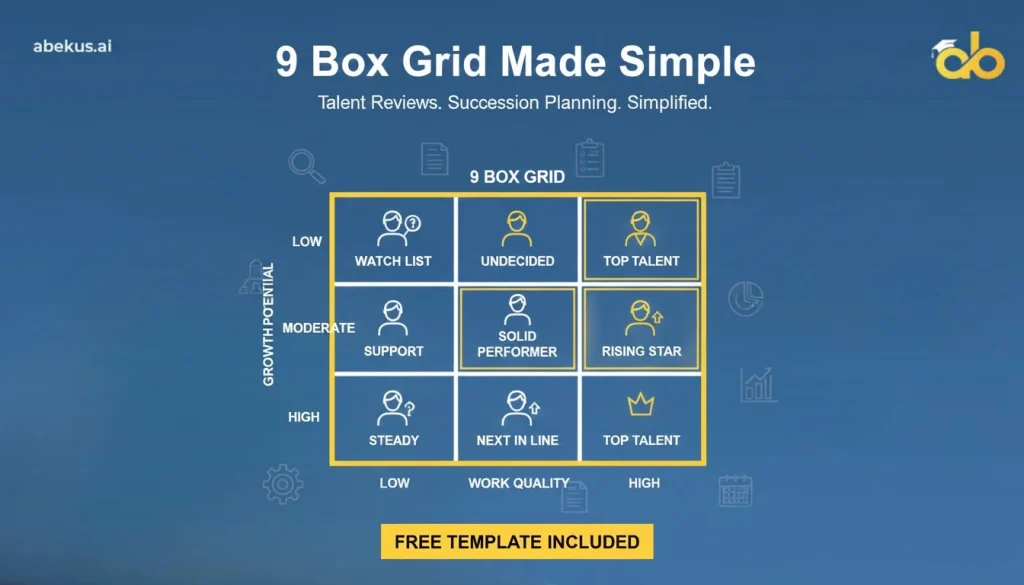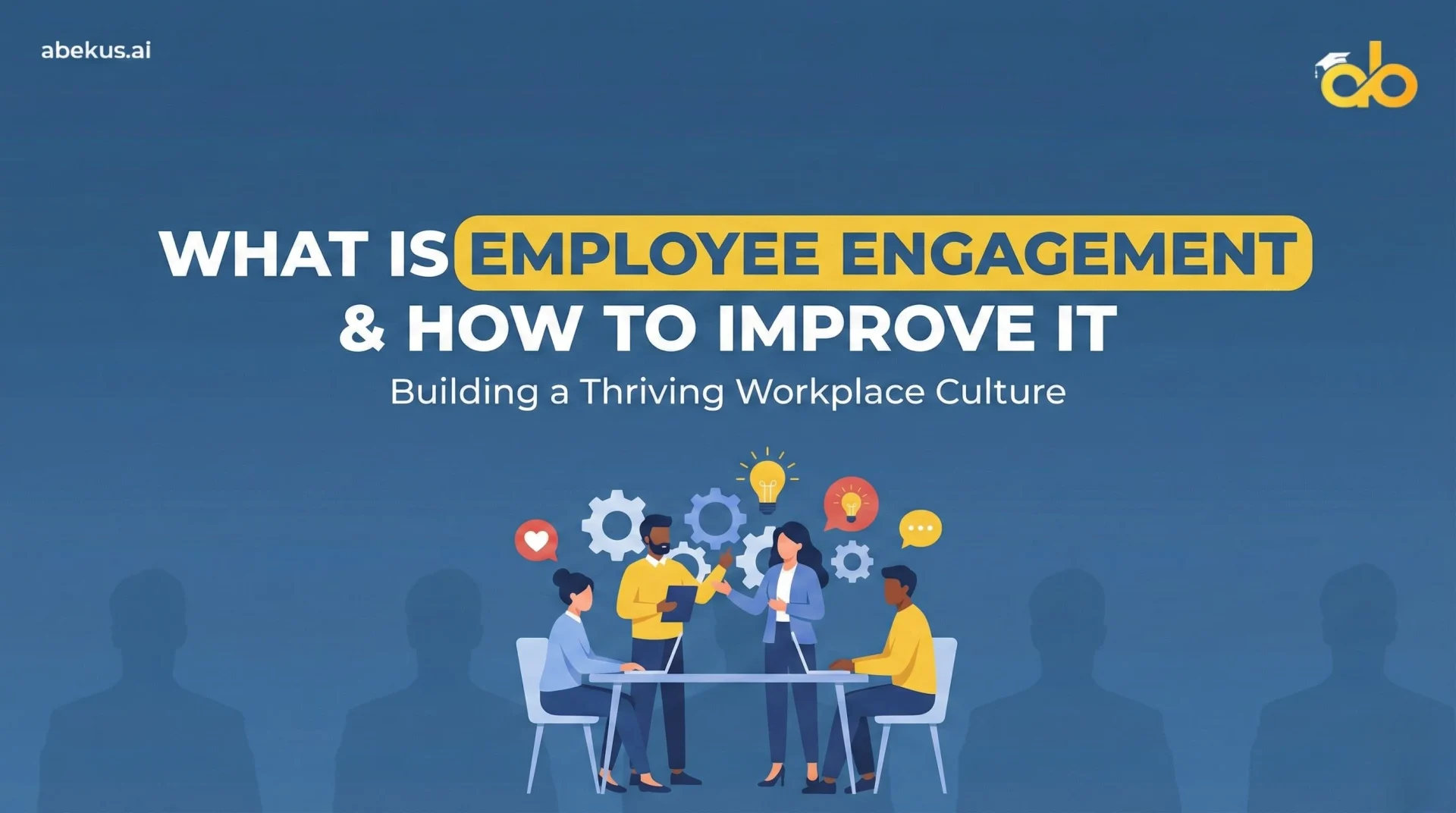The 9 Box Grid is a simple yet powerful tool used in talent reviews and succession planning. It helps HR teams and managers group employees based on performance and potential, giving you clear visibility into your workforce strengths and development opportunities.
But here is the reality: many organizations still find it confusing or too theory-heavy. This comprehensive guide breaks down the 9 box talent matrix in a practical way, so you can actually use it during real conversations and reviews. Plus, we have included implementation strategies and actionable next steps for each box.
Whether you are in HR or leading a team, this is a smart way to get a clearer picture of where your people stand and what comes next for their development.
What Is the 9 Box Grid?
The 9 Box Grid is a strategic HR tool that creates a visual map of your talent. Think of it as a simple chart, but one with powerful implications for your workforce planning.
The Basic Structure
HR teams across the globe use this grid to evaluate and categorize employees based on two critical dimensions:
Performance (horizontal axis): How well someone executes their current role
Potential (vertical axis): Their capacity for growth and future leadership
This creates a 3×3 matrix with nine distinct boxes. Each box represents a unique combination of current performance and future potential, helping you make informed decisions about development, promotion, and succession planning.
Primary Uses of the 9 Box Grid
Organizations leverage this talent management tool for several strategic purposes:
- Leadership development planning to identify future leaders
- Succession planning to ensure business continuity
- Performance review discussions with clearer context
- Talent development programs tailored to each segment
- Resource allocation decisions for training and coaching
- Retention strategies focused on high-value employees
- Team composition analysis to balance talent distribution
The 9 box performance matrix gives you a snapshot of your entire team’s capability landscape, making talent decisions more objective and strategic.
Understanding the Two Core Axes of the 9 Box Grid
Before we explore the nine boxes themselves, it is essential to understand what each axis truly measures and how to evaluate employees on these dimensions.
Axis 1: Current Performance (Work Quality)
This measures how effectively someone handles their present responsibilities. It answers the question: “How well is this person doing in their current role right now?”
Performance Rating Levels
Low Performance: Inconsistent delivery, frequently misses expectations, requires significant management oversight, or struggles with core responsibilities.
Moderate Performance: Steady and dependable contributor, meets expectations consistently, delivers reliable results, but has room for improvement in quality or efficiency.
High Performance: Consistently exceeds expectations, delivers exceptional results, requires minimal oversight, and often serves as a benchmark for others.
How to Measure Performance Accurately
Use multiple data sources to ensure objectivity:
- Manager evaluations based on defined KPIs and objectives
- Project outcomes and deliverables with measurable results
- Peer feedback for collaborative work assessment
- Client or customer responses when applicable
- Quantitative metrics specific to the role (sales numbers, code quality, project timelines)
- Quality assessments of work output over time
The key is to base performance ratings on observable facts and documented evidence, not subjective impressions or recent events alone.
Axis 2: Future Potential (Growth Capacity)
This evaluates how ready and capable someone is to take on greater responsibilities. It answers: “How far can this person grow within the organization?”
What Potential Really Means
Potential is not just about ambition or energy. It encompasses several critical factors:
Learning agility: How quickly they absorb new concepts and apply them
Adaptability: Their comfort level with change and uncertainty
Initiative and ownership: Willingness to take on challenges without prompting
Leadership qualities: Ability to influence, guide, and inspire others
Strategic thinking: Capacity to see beyond immediate tasks to bigger picture
Emotional intelligence: Self-awareness and ability to work effectively with others
Potential Rating Levels
Low Potential: Content in current role, limited interest in advancement, struggles with new challenges, or lacks capacity for higher-level responsibilities.
Moderate Potential: Shows promise for growth, willing to learn, can handle increased responsibility with proper support and development.
High Potential: Demonstrates clear readiness for advancement, quickly masters new skills, seeks challenges, and shows strong leadership indicators.
How to Assess Potential Fairly
Evaluate potential through multiple lenses:
- Behavioral observations during challenging situations
- Learning curve analysis when given new assignments
- Self-assessment and career aspirations discussions
- Peer and cross-functional feedback on collaboration
- Response to feedback and willingness to develop
- Track record of growth within the organization
- Performance in stretch assignments or temporary leadership roles
Remember that potential can develop over time. Someone with moderate potential today might become high potential with the right experiences and development.
How to Build Your 9 Box Grid: 4 Strategic Steps
Creating an effective 9 box talent grid requires systematic evaluation and thoughtful placement. Here is the proven process used by successful HR teams.
Step 1: Establish Your Rating System
Before you start evaluating anyone, create clear, consistent standards that everyone understands.
Choose Your Rating Scale
Option A: Simple 3-Point Scale (Recommended for most teams)
- 1 = Low
- 2 = Moderate
- 3 = High
Option B: Detailed 5-Point Scale (For larger organizations)
- 1 = Well Below Expectations
- 2 = Below Expectations
- 3 = Meets Expectations
- 4 = Exceeds Expectations
- 5 = Far Exceeds Expectations
Define Each Rating Level Clearly
Create written descriptions that remove ambiguity. Here is an example for a 3-point scale:
| Rating | Performance Definition | Potential Definition |
|---|---|---|
| 1 (Low) | Consistently below expectations, requires improvement plan | Limited capacity or interest for growth beyond current role |
| 2 (Moderate) | Meets expectations reliably, solid contributor | Can grow with proper development and support |
| 3 (High) | Consistently exceeds expectations, top performer | Ready for advancement, shows clear leadership qualities |
Use Recent, Relevant Data
Base ratings on:
- Performance from the past 6 to 12 months (not outdated history)
- Multiple data points, not single incidents
- Documented evidence, not assumptions
- Consistent criteria applied to all employees equally
Step 2: Conduct Thorough Employee Reviews
This is where objectivity and fairness become critical.
Gather Multiple Perspectives
Manager input: Primary evaluator with daily visibility
Self-assessment: Employee’s perspective on their performance and aspirations
Peer feedback: Insights from colleagues who work directly with the person
Cross-functional input: Feedback from other departments when relevant
Historical performance data: Trends over time, not just recent performance
Reduce Bias Through Structure
Common biases to actively avoid:
Recency bias: Overweighting recent events while ignoring overall patterns
Halo effect: Letting one strong trait influence all ratings
Similarity bias: Rating people higher because they remind you of yourself
Leniency or strictness bias: Being consistently too easy or too hard
Comparison bias: Rating against other people instead of against standards
Use calibration sessions where multiple managers review ratings together to ensure consistency across the organization.
Step 3: Place Employees into the Grid
Now comes the mapping process. Take each person’s two ratings (performance and potential) and place them in the corresponding box.
The 9 Box Grid Layout
Here is what your completed grid structure looks like:
| Performance → Potential ↓ | Low Performance | Moderate Performance | High Performance |
|---|---|---|---|
| High Potential | Box 3: Rough Diamond | Box 6: Rising Star | Box 9: Top Talent |
| Moderate Potential | Box 2: Inconsistent Player | Box 5: Core Player | Box 8: High Professional |
| Low Potential | Box 1: Underperformer | Box 4: Solid Citizen | Box 7: Trusted Professional |
Visual Representation
HIGH POTENTIAL
↑
[Box 3] [Box 6] [Box 9]
[Box 2] [Box 5] [Box 8]
[Box 1] [Box 4] [Box 7]
LOW ← PERFORMANCE → HIGHEach employee receives one placement based on their combined performance and potential scores.
Step 4: Develop Action Plans for Each Box
The grid itself is just a diagnostic tool. The real value comes from what you do next.
For each box, you should have:
- Clear development strategies tailored to that segment
- Timeline expectations for growth or improvement
- Resource allocation plans (coaching, training, mentoring)
- Success metrics to track progress
- Regular review cadence to reassess placement
The 9 Boxes Explained: What Each Means and What to Do
Let us explore each box in detail with practical actions you can take immediately.
Box 1: Underperformer (Low Performance, Low Potential)
What it means: This employee is struggling in their current role and shows limited capacity or interest in improvement or growth.
Red flags to watch:
- Consistently misses deadlines or quality standards
- Shows resistance to feedback or development
- Lacks engagement with team or organizational goals
- Has received multiple improvement plans with limited progress
Action strategies:
- Have an honest conversation: Discuss performance gaps candidly and clearly
- Create a performance improvement plan: Set specific, measurable goals with 30 to 90 day timeline
- Provide targeted support: Assign a mentor or offer specific skill training
- Evaluate role fit: Consider if a different position might be better suited
- Make difficult decisions: If improvement does not occur, transition planning may be necessary
Manager’s focus: Short-term goals with clear metrics. Weekly check-ins to monitor progress.
Box 2: Inconsistent Player (Low Performance, Moderate Potential)
What it means: This person has capability but is not delivering results yet. The picture is unclear and needs more time and support.
Common scenarios:
- New hire still in onboarding phase
- Employee dealing with personal challenges
- Someone in a role that does not match their strengths
- High potential person who recently stumbled
Action strategies:
- Investigate root causes: Understand what is blocking performance
- Increase feedback frequency: Move to weekly or bi-weekly check-ins
- Provide clear expectations: Remove ambiguity about what success looks like
- Offer developmental support: Training, mentoring, or coaching as appropriate
- Monitor closely: Set 60 to 90 day checkpoints to reassess
Manager’s focus: Supportive guidance with clear accountability. This box should be temporary.
Box 3: Rough Diamond (Low Performance, High Potential)
What it means: This person has significant potential and energy but is not yet delivering results. They need fuel, direction, and structure.
Common profile:
- Ambitious but inexperienced
- Great ideas but poor execution
- High energy but lacks focus
- Strong potential clouded by early struggles
Action strategies:
- Assign challenging projects with strong guidance: Give them opportunities to prove themselves with support
- Pair with a strong mentor: Someone who excels in execution can model good practices
- Provide structured feedback: Regular, specific input on what is working and what needs adjustment
- Set clear milestones: Break bigger goals into smaller, achievable steps
- Invest in skill development: Training in their weak areas (time management, technical skills, etc.)
Manager’s focus: High-touch coaching. This is a high-investment category that can yield excellent returns.
Box 4: Solid Citizen (Moderate Performance, Low Potential)
What it means: Reliable and steady worker who meets expectations but is unlikely to advance significantly. They provide stability to the team.
Value to the organization:
- Consistent delivery without drama
- Deep knowledge of processes and systems
- Often serve as team anchors
- Require minimal management oversight
Action strategies:
- Recognize their stability: Acknowledge the value they bring
- Provide role clarity: Ensure they understand their importance
- Offer skill refreshers: Keep their capabilities current
- Create mastery opportunities: Let them become experts in their domain
- Avoid pushing for growth they do not want: Respect their career choice
Manager’s focus: Appreciation and retention. Not everyone needs or wants to climb the ladder, and that is perfectly acceptable.
Box 5: Core Player (Moderate Performance, Moderate Potential)
What it means: The backbone of your organization. Dependable, reliable team members who get the job done and have room to grow with proper development.
Why they matter:
- Consistent, predictable performance
- Team players who collaborate well
- Open to learning and development
- Often the largest segment in healthy organizations
Action strategies:
- Provide regular recognition: Acknowledge their contributions frequently
- Offer lateral moves: Expose them to different areas for skill building
- Prepare for expanded scope: Give them stretch assignments to test readiness
- Invest in development: Training and workshops to build capabilities
- Create clear growth paths: Show them what advancement could look like
Manager’s focus: Development and engagement. These employees can move up or sideways with the right support.
Box 6: Rising Star (High Performance, Moderate Potential)
What it means: This person is performing very well in their current role and shows readiness to take on more. They are your future leaders in development.
Characteristics:
- Consistently delivers strong results
- Eager to learn and grow
- Shows leadership qualities
- Respected by peers
Action strategies:
- Assign mini-leadership roles: Team lead on projects, training new hires, etc.
- Provide stretch assignments: Give them challenges slightly beyond current role
- Create visibility: Introduce them to senior leadership
- Offer targeted development: Leadership training, executive coaching
- Fast-track selectively: Accelerate their progression where appropriate
Manager’s focus: Acceleration and preparation. These are your succession plan candidates.
Box 7: Trusted Professional (High Performance, Low Potential)
What it means: Exceptional at their job with no particular interest or capacity for advancement. These are your subject matter experts and technical specialists.
Their unique value:
- Deep expertise in their domain
- Consistently excellent work
- Often mentor others
- Provide technical backbone
Action strategies:
- Retain and reward: Compensation and recognition programs
- Create expert tracks: Career progression that does not require management
- Leverage their expertise: Have them train others or lead technical initiatives
- Avoid burnout: Monitor workload, as they often get overloaded
- Respect their choice: Not everyone aspires to management
Manager’s focus: Retention and appreciation. Keep them engaged and prevent competitor poaching.
Box 8: High Professional (High Performance, High Potential)
What it means: Ready for leadership roles in the near term. They are performing exceptionally and show clear capacity for more responsibility.
Next-level indicators:
- Consistently exceeds goals
- Shows strategic thinking
- Influences beyond their role
- Demonstrates leadership presence
Action strategies:
- Begin transition planning: Identify specific next roles
- Provide executive coaching: Prepare them for leadership challenges
- Give leadership opportunities: Acting roles, project ownership
- Increase visibility: Present to board, lead cross-functional initiatives
- Create succession timeline: Clear path to advancement within 12 to 24 months
Manager’s focus: Leadership preparation. Start delegating higher-level responsibilities.
Box 9: Top Talent (High Performance, High Potential)
What it means: Your absolute best. The full package. Ready, steady, and sharp. These are your current and future organizational leaders.
Why they are critical:
- Drive business results
- Inspire others
- Can handle any challenge
- High retention risk if not engaged
Action strategies:
- Fast-track deliberately: Clear acceleration plan
- Invest heavily: Executive coaching, advanced training, external programs
- Provide maximum exposure: Board presentations, strategic projects, external speaking
- Create retention plans: Competitive compensation, equity, meaningful work
- Challenge consistently: Ensure they never feel stagnant
Manager’s focus: Retention and acceleration. These are your succession plan for senior roles. Competitors will target them.
9 Box Grid Best Practices: How to Maximize Its Value
The difference between organizations that benefit from the 9 box grid and those that waste time on it comes down to execution. Here are proven practices from high-performing HR teams.
Use Multiple Reviewers for Objectivity
Why it matters: Single-person evaluations often carry unconscious bias.
How to do it:
- Require manager and skip-level input
- Include peer feedback where appropriate
- Use 360-degree assessments for leadership roles
- Hold calibration sessions across departments
Conduct Reviews Quarterly, Not Annually
Why it matters: Talent shifts faster than yearly cycles. People grow, struggle, or disengage between annual reviews.
How to do it:
- Full 9 box review quarterly
- Monthly check-ins on employees in transition boxes (1, 2, 3)
- Continuous feedback culture between formal reviews
Base Ratings on Evidence, Not Opinions
Why it matters: Subjective impressions lead to unfair placements and poor decisions.
How to do it:
- Document specific examples supporting each rating
- Use data wherever possible (sales numbers, project completion rates, peer ratings)
- Reference actual behaviors and outcomes
- Avoid phrases like “I feel like” or “They seem to”
Clarify the Purpose to Your Team
Why it matters: Transparency builds trust. Secret talent assessments create anxiety and resentment.
How to do it:
- Explain that the grid is a planning tool, not a punishment system
- Share how ratings are determined
- Discuss placements openly during performance reviews
- Show employees their development path based on their box
Take Action on Every Box
Why it matters: A grid without action plans is wasted effort.
How to do it:
- Create specific development plans for each employee based on their placement
- Allocate resources (budget, time, coaching) according to strategic priorities
- Set timelines and checkpoints for progress
- Track outcomes to validate your strategies
Common 9 Box Grid Mistakes to Avoid
Even experienced HR teams fall into these traps. Learn from others’ errors:
Mistake 1: Guessing at Ratings Without Evidence
The problem: Relying on gut feeling or recent impressions rather than data.
The fix: Require documented evidence for each rating. No evidence means you need more observation time before placing someone.
Mistake 2: Annual Assessment Only
The problem: Talent dynamics change throughout the year. Someone who was a rising star in January might be disengaged by October.
The fix: Conduct quarterly reviews with monthly check-ins for employees in critical boxes.
Mistake 3: Ignoring the Middle (Box 5)
The problem: Focusing all attention on top talent (boxes 8 and 9) and underperformers (boxes 1 and 2) while neglecting your core performers.
The fix: Remember that box 5 often contains the majority of your workforce. They deserve development plans too.
Mistake 4: Using It as a Labeling Tool
The problem: Treating placements as permanent judgments rather than current snapshots that can change.
The fix: Clearly communicate that placement is based on current performance and potential. People can and do move between boxes with development and effort.
Mistake 5: Confusing Potential with Ambition
The problem: Assuming that everyone wants to advance into management or leadership.
The fix: Assess potential for growth in various directions (technical expertise, project leadership, mentorship) not just upward promotion.
Mistake 6: Letting Politics Influence Placement
The problem: Placing favorite employees higher or difficult personalities lower regardless of actual performance and potential.
The fix: Use calibration sessions where multiple leaders review placements together. Data and evidence should override opinions.
How Technology Can Simplify Your 9 Box Grid Process
If you are still juggling spreadsheets, collecting feedback through email chains, and manually updating your talent grid, there is a better way to manage this critical process.
The Challenge with Manual 9 Box Grids
Time-consuming data collection: Chasing manager feedback, consolidating inputs, and updating spreadsheets
Inconsistent application: Different managers using different standards
Difficulty tracking changes: Hard to see how individuals move through boxes over time
Limited accessibility: Spreadsheets sitting on one person’s computer
No reminder system: Missed check-ins and forgotten development plans
How Abekus Transforms Talent Management
Abekus is an AI-powered platform that helps HR teams simplify the entire talent mapping and assessment process. It pulls in data from multiple sources and creates clear visibility into your talent landscape without spending hours building charts manually.
What Abekus enables:
Auto-generate 9 Box Grids: Connect your HRIS or performance management system and automatically populate your grid based on current data. No more manual entry.
Track movement over time: Visualize how employees move between boxes across quarters. Identify rising stars early and spot flight risks before they disengage.
Set automated reminders: Never miss check-ins, feedback loops, or development action items. The system prompts managers when reviews are due.
Centralize feedback: Collect manager, peer, and self-assessments in one place with consistent rating criteria across the organization.
Generate visual reports: Share professional talent maps with leadership in just a click. Export for board presentations or strategic planning sessions.
Identify patterns: See which departments have talent gaps, which teams develop people effectively, and where succession risks exist.
Skills-based insights: Go beyond traditional performance metrics to include skills assessments, helping you make development decisions based on actual capabilities.
By reducing the administrative burden of talent management, Abekus allows HR teams to focus on what really matters: having meaningful conversations with employees and creating development experiences that help people grow.
Learn more about how Abekus can transform your talent management process →
9 Box Grid Template and Implementation Checklist
Ready to implement your own 9 box grid? Use this checklist to ensure successful adoption.
Phase 1: Preparation (Week 1-2)
- Define your rating scale (3-point or 5-point)
- Write clear definitions for each performance level
- Write clear definitions for each potential level
- Create rating guidelines document for managers
- Schedule calibration sessions with leadership team
- Decide on review frequency (recommend quarterly)
- Set up your grid template (digital or physical)
Phase 2: Assessment (Week 3-4)
Phase 3: Action Planning (Week 5-6)
- Collect manager performance ratings with evidence
- Gather peer feedback where appropriate
- Review employee self-assessments
- Compile objective performance data (KPIs, metrics)
- Conduct calibration sessions to ensure consistency
- Finalize placements with documented rationale
Phase 3: Action Planning (Week 5-6)
- Create specific development plan for each box
- Assign resources (coaching, training, mentoring)
- Set timelines and milestones for development
- Schedule follow-up reviews for each employee
- Allocate budget for training and development
- Identify succession gaps and create backup plans
Phase 4: Communication (Week 7-8)
- Discuss placements with each employee individually
- Explain development plan and next steps
- Address concerns and answer questions
- Set expectations for progress timelines
- Document commitments from both sides
- Schedule first development check-in
Phase 5: Ongoing Management
- Monthly check-ins for boxes 1, 2, 3 (high-touch needed)
- Quarterly check-ins for boxes 4, 5, 6, 7
- Bi-monthly for boxes 8, 9 (retention focus)
- Quarterly full grid review and updates
- Annual assessment of grid effectiveness
- Continuous improvement of process based on outcomes
Measuring Success: KPIs for Your 9 Box Grid Program
How do you know if your 9 box grid is actually working? Track these key metrics:
Talent Movement Metrics
Upward mobility rate: Percentage of employees moving to higher-potential or higher-performance boxes
Target: 15-20% of employees showing positive movement annually
Time to promotion: Average time for box 6, 8, 9 employees to advance
Target: Faster than organization average
Retention by box: Track turnover rates for each box separately
Target: Less than 5% annual turnover in boxes 7, 8, 9
Development Effectiveness
Plan completion rate: Percentage of development plans actually executed
Target: 80%+ completion
Skill acquisition: Percentage of employees gaining planned competencies
Target: 70%+ successful skill development
Leadership pipeline health: Number of ready-now successors for critical roles
Target: 2-3 qualified candidates for each key position
Business Impact
Performance improvement: Percentage of box 1-3 employees who improve
Target: 50%+ show improvement within 6 months
High performer retention: Retention rate of boxes 7, 8, 9
Target: 90%+ annual retention
Succession readiness: Percentage of key roles with identified successors
Target: 100% of critical roles covered
Final Thoughts: Making the 9 Box Grid Work for Your Organization
The 9 Box Grid is not just for identifying your star performers. It is a strategic mirror that helps you see every team member more clearly: who is ready for more, who might need support, and who is quietly climbing.
The real magic happens when you use this clarity to build meaningful development paths for every employee, not just those at the top. A well-implemented 9 box system creates:
Better development conversations: Managers have frameworks for discussing growth
Clearer career paths: Employees understand how to advance
Stronger succession plans: Organizations are prepared for leadership transitions
Higher retention: People stay when they see investment in their growth
More objective decisions: Promotion and development choices are based on data
Remember that the grid is a tool, not a destination. The placements are snapshots in time that should change as people grow, develop, and demonstrate new capabilities. The goal is not to categorize people permanently but to understand where they are now so you can help them get where they want to go.
Start simple, be consistent, act on the insights, and refine your approach over time. That is how high-performing organizations turn talent management from an HR exercise into a competitive advantage.
Frequently Asked Questions About the 9 Box Grid
What is a 9 Box Grid?
The 9 Box Grid is a strategic talent management tool used in HR to evaluate and categorize employees based on two dimensions: current performance and future potential. It is a visual 3×3 matrix that helps managers group employees into nine categories, making it easier to identify development needs, succession candidates, and retention priorities.
The grid provides a clear snapshot of your workforce, showing you where talent strengths and gaps exist across your organization.
How do you use the 9 Box Grid in HR?
Using the 9 Box Grid involves a systematic process:
Step 1: Rate current performance using defined criteria and evidence from manager reviews, KPIs, and peer feedback.
Step 2: Rate future potential by assessing learning agility, leadership qualities, and capacity for growth.
Step 3: Plot employees on the grid by combining both ratings to place each person in one of nine boxes.
Step 4: Create action plans with specific development strategies tailored to each box.
Step 5: Review and update regularly on a quarterly basis to track progress and adjust placements.
The key is to use it as a planning tool, not a labeling system. Every placement should lead to a specific development action.
Who created the 9 Box Grid?
The 9 Box Grid was originally developed by McKinsey and Company for General Electric as part of their internal talent management and succession planning system. It has since been widely adopted across industries and is now considered a standard tool in strategic HR practices.
While the original application was for leadership development, modern organizations use it for talent assessment at all levels.
What are the limitations of the 9 Box Grid?
The 9 Box Grid has several important limitations to be aware of:
Subjectivity in measurement: There is no universal formula to measure potential accurately. Different managers may interpret criteria differently, leading to inconsistent ratings.
Snapshot limitation: The grid captures a moment in time. Performance and potential both fluctuate, so a single assessment can be misleading if not updated regularly.
Risk of labeling: If not communicated carefully, employees may feel permanently categorized, which can damage morale and motivation.
Bias potential: Like any evaluation tool, the 9 Box Grid is susceptible to recency bias, halo effect, and other cognitive biases if not managed carefully.
Oversimplification: Reducing complex human capabilities to two dimensions inevitably loses nuance and context.
How to mitigate these limitations:
- Use multiple reviewers for each assessment
- Update the grid quarterly, not annually
- Base ratings on documented evidence, not opinions
- Train managers on bias recognition and mitigation
- Communicate transparently with employees about the process
How do you score a 9 Box Grid?
Scoring involves rating each employee on both dimensions using a consistent scale. Here is a practical scoring framework:
For a 3-point scale:
| Performance Rating | Potential Rating | Grid Placement |
|---|---|---|
| 1 (Low) | 1 (Low) | Box 1: Underperformer |
| 1 (Low) | 2 (Moderate) | Box 2: Inconsistent Player |
| 1 (Low) | 3 (High) | Box 3: Rough Diamond |
| 2 (Moderate) | 1 (Low) | Box 4: Solid Citizen |
| 2 (Moderate) | 2 (Moderate) | Box 5: Core Player |
| 2 (Moderate) | 3 (High) | Box 6: Rising Star |
| 3 (High) | 1 (Low) | Box 7: Trusted Professional |
| 3 (High) | 2 (Moderate) | Box 8: High Professional |
| 3 (High) | 3 (High) | Box 9: Top Talent |
Best practices for scoring:
- Gather data from multiple sources (manager, peers, self-assessment)
- Document specific examples supporting each rating
- Use calibration sessions to ensure consistency across teams
- Review 6-12 months of performance data, not just recent events
- Separate performance from likability or personal rapport
Can employees see their 9 Box Grid placement?
This depends on organizational culture and transparency philosophy. There are two common approaches:
Full transparency approach: Share placements openly during performance reviews. This builds trust and allows for honest development conversations.
Selective transparency approach: Discuss performance and potential separately without explicitly showing the grid. This avoids the perception of permanent labeling.
Most modern HR experts recommend transparency with proper context. When employees understand:
- How ratings are determined
- That placements can change
- What development is planned
- How the grid supports their growth
They respond more positively and engage more actively in their development.
The key is framing: present it as a development tool, not a judgment system.
How often should you update the 9 Box Grid?
Recommended frequency: Quarterly reviews with monthly monitoring.
Quarterly full assessments allow you to:
- Capture performance changes before they become critical
- Adjust development plans based on progress
- Identify emerging talent or declining performance early
- Keep succession plans current
Monthly check-ins for specific boxes:
- Boxes 1, 2, 3: High-touch monitoring needed
- Boxes 8, 9: Retention focus and leadership development tracking
Annual comprehensive review: Validate your entire process, assess which development strategies worked, and refine your approach.
One-year cycles are too slow. Talent dynamics shift quarterly in most organizations. People get promoted, change roles, face personal challenges, or suddenly excel. Your grid should reflect these realities in near real-time.






